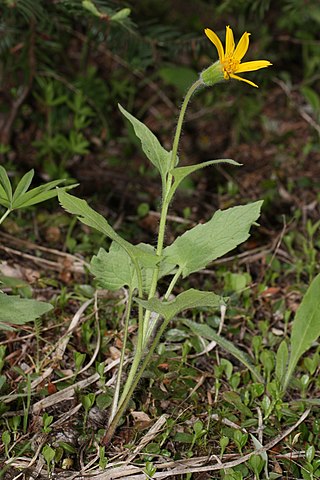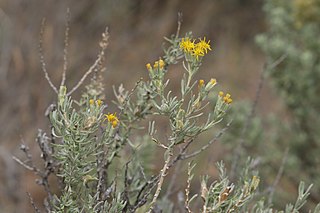
Petasites frigidus, the Arctic sweet coltsfoot or Arctic butterbur, is a species of flowering plant in the family Asteraceae. It is native to Arctic to cool temperate regions of the Northern Hemisphere in northern Europe, northern Asia and northern North America.

Lilium humboldtii, or Humboldt's lily, is a species of lily native to the US state of California and the Mexican state of Baja California. It is named after naturalist and explorer Alexander von Humboldt. It is native to the South High Cascade Range, High Sierra Nevada, south Outer South Coast Ranges, and the Santa Monica Mountains and others in Southern California, growing at elevations from 600 metres (2,000 ft) to 1,200 metres (3,900 ft).

Fritillaria affinis, the chocolate lily, is a highly variable species of flowering plant in the lily family Liliaceae native to western North America.

Xerophyllum tenax is a North American species of plants in the corn lily family. It is known by several common names, including bear grass, soap grass, quip-quip, and Indian basket grass.

Lilium pardalinum, also known as the leopard lily or panther lily, is a flowering bulbous perennial plant in the lily family, native to Oregon, California, and Baja California. It usually grows in damp areas. Its range includes California chaparral and woodlands habitats and the Sierra Nevada.

Linum lewisii is a perennial plant in the family Linaceae, native to western North America from Alaska south to Baja California, and from the Pacific Coast east to the Mississippi River. It grows on ridges and dry slopes, from sea level in the north up to 11,000 feet in the Sierra Nevada.

Dicentra formosa is a flowering plant with fern-like leaves and an inflorescence of drooping pink, purple, yellow or cream flowers native to the Pacific Coast of North America.

Allium validum is a species of flowering plant commonly called swamp onion, wild onion, Pacific onion, or Pacific mountain onion. It is native to the Cascade Range, to the Sierra Nevada, the Rocky Mountains, and other high-elevation regions in California, Oregon, Washington, Nevada, Idaho and British Columbia. It is a perennial herb and grows in swampy meadows at medium and high elevations.

Lilium washingtonianum is a North American plant species in the lily family. It is also known as the Washington lily,Shasta lily, or Mt. Hood lily. It is named after Martha Washington and not the state of Washington; in fact, as the northern range of the plant is near Mount Hood in Oregon, it does not naturally occur in the state of Washington.

Calochortus macrocarpus, also known as sagebrush mariposa lily, is a North American species of bulbous perennials in the lily family.

Erythronium grandiflorum is a North American species of plants in the lily family. It is known by several common names, including yellow avalanche lily, glacier lily, and dogtooth fawn lily. The Ktunaxa name for glacier lily is maxa.

Erythronium oregonum is a North American species of flowering plant in the lily family which is known by the common name giant white fawnlily or Oregon fawn-lily.

Sambucus racemosa is a species of elderberry known by the common names red elderberry and red-berried elder.

Arnica cordifolia is a species of arnica in the sunflower family, known by the common name heartleaf arnica. It is native to western North America.

Chaenactis douglasii is a North American species of flowering plant in the daisy family known by the common name Douglas' dustymaiden.

Lilium kelleyanum is a California species of lily known by the common name Kelley's lily. It grows primarily in wetlands in the Sierra Nevada as well as in the Coast Ranges and southern Cascades in the northern part of the state.

Lilium occidentale is a rare North American species of lily known by the common name western lily. Its species name 'Occidentale' means 'westernmost' and refers to its location along the West Coast. It is native to northwestern California and southwestern Oregon. It grows in coastal prairie habitat, swamps and stagnant bogs with Drosera species, bluffs and sandy cliffs, and seaside spruce forests. This rare wildflower is limited in distribution and directly endangered by a number of environmental factors. It is a federally listed endangered species and it is listed as endangered by the states of California and Oregon.

Tetradymia argyraea is a species of flowering plant in the aster family known by the common names spineless horsebrush and gray horsebrush. It is native to western North America.

Erigeron filifolius is a North American species of flowering plants in the family Asteraceae known by the common names thread-leaf fleabane.

Circaea alpina, commonly called alpine enchanter's nightshade or small enchanter's nightshade, is a 10–30 cm tall perennial herb found in cool forests of the Northern Hemisphere.




























